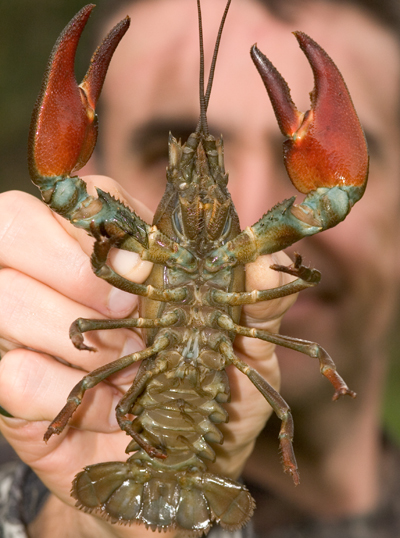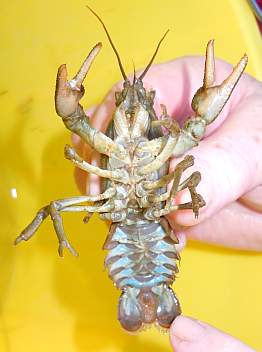The Eden Rivers Trust report that:
This is extremely bad news for the endangered native white-clawed crayfish whose best stronghold in Britain is in the Eden Valley.
White-clawed crayfish are an endangered species and the River Eden is of such importance for these creatures that it is designated as a Site of Special Scientific Interest by the UK Government and a Special Area of Conservation by the European Union to protect them.
The main threat to our native crayfish is the non-native North American signal crayfish, which is larger, out-competes and even eats our native crayfish. Most worryingly of all they carry a fungal disease called crayfish plague, which is deadly to our native crayfish.
Up until now, the Eden had been surrounded by populations of the non-native signal crayfish, but had remained the largest river system in Britain supporting healthy native crayfish populations and no non-native crayfish or crayfish plague.
 Following a report of dead crayfish washed out of a beck in flooding, a signal crayfish population has been discovered in a small tributary of the River Eden in north Cumbria. It appears likely that this particular population of signal crayfish has existed for many years. The two species are not currently overlapping in their distributions in the River Eden system, but if they did occur together it is likely that the signal crayfish would eradicate the native crayfish.
Following a report of dead crayfish washed out of a beck in flooding, a signal crayfish population has been discovered in a small tributary of the River Eden in north Cumbria. It appears likely that this particular population of signal crayfish has existed for many years. The two species are not currently overlapping in their distributions in the River Eden system, but if they did occur together it is likely that the signal crayfish would eradicate the native crayfish.
It is not yet known if the signal crayfish population carries crayfish plague, but the disease is easily spread in water and mud, so all precautions should be taken by river users. To prevent further spread of the signal crayfish and crayfish plague it is essential that river users take biosecurity precautions when moving between rivers. River users are being asked to Check, Clean and Dry all of their equipment thoroughly before using it on another water body.
The Environment Agency, Natural England and Eden Rivers Trust will be working together to discover how far the population has spread. Ponds in the area will also be checked and the situation will be monitored.
 Eradication of the signal crayfish population is extremely difficult to achieve. Using chemicals in rivers to kill crayfish also kills all other river wildlife. Trapping tends to mainly catch large crayfish and will not catch all individuals present. In some cases trapping large crayfish can actually help to increase the population because large crayfish eat a lot of the smaller ones and so removing large crayfish lets more young crayfish survive.
Eradication of the signal crayfish population is extremely difficult to achieve. Using chemicals in rivers to kill crayfish also kills all other river wildlife. Trapping tends to mainly catch large crayfish and will not catch all individuals present. In some cases trapping large crayfish can actually help to increase the population because large crayfish eat a lot of the smaller ones and so removing large crayfish lets more young crayfish survive.
All crayfish trapping requires a licence from the Environment Agency. There is also a considerable amount of legislation in place to protect the white-clawed crayfish. A series of licences are needed for working with white-clawed and non-native crayfish.
The signal crayfish is much larger than the native white-clawed crayfish and reaches a maximum size of 16-18 cm. Its claws have red undersides with a small turquoise-white blotch on the upper surface at the claw hinge. It is native to western North America and was first introduced to this country in 1976 to be farmed for food. It escaped through water courses and across land, and then spread rapidly across Britain throughout the 1970s and 1980s. Dispersal has also been aided by human transfer and release of individuals, although this is now illegal.
Signal crayfish have become well established in England and Wales, especially in the south-east of England. They are also present just over the border in Scotland.
Signal crayfish are driving native crayfish towards extinction through competition for resources and crayfish plague. They grow faster, reproduce more rapidly, are more aggressive and are tolerant of a wider range of conditions than the white-clawed crayfish, and therefore out-compete the native species. They feed on fish and amphibian eggs, tadpoles, juvenile fish, aquatic invertebrates, detritus and aquatic vegetation and so reduce populations of native species and affect food webs.
Severe damage to waterways occurs where signal crayfish populations exist. They tunnel extensively into banks and tunnels can be up to 2 m deep with many inter-connecting tunnels that weaken the bank. This can contribute to problems of erosion, livestock safety, flooding and the stability of structures built on the banks.
Signal crayfish have been shown to negatively affect fish populations by eating fish eggs and competing with fish for places to hide. Increased silt due to erosion can blanket the river bed and the gravels where fish spawn.
It is important for the ecology of our rivers that non-native species of crayfish like the signal crayfish are not spread accidentally or deliberately. Under the Wildlife & Countryside Act 1981 it is illegal to release (or allow to escape) any non-native crayfish into the wild. It is possible that this population may precede this legislation and the Environment Agency is currently investigating the possible source. In other parts of the country non-native crayfish have spread by escaping from fish farms, accidental introductions with fish stocking, introductions to ornamental ponds, discarding of aquarium specimens or deliberate release.
Jeremy Westgarth, Environment Manager at the Environment Agency, said:
“We are so lucky to have such a fantastic environment on our doorstep in Cumbria. However the spread of signal crayfish presents a significant threat to our rivers and the native crayfish in them. It’s vital that everyone does everything they can to prevent further spread.”
Simon Humphries, Area Manager, Natural England, said:
“Non-native species are one of the biggest threats to our freshwater environment. The River Eden is such a special river and so important for so many species that we must do all we can to halt the spread of plants and animals that threaten this special place.”
Simon Johnson, Director of Eden Rivers Trust, said:
“The spread of signal crayfish to the Eden system is the worst possible news. This most unwelcome of visitors presents a significant risk to our precious and unique natural heritage. However, the population is contained to one small area of the catchment and we must do all we can to keep it that way. I would encourage all those who come into contact with the river to adopt the Check, Clean, Dry approach to support our efforts to stop the spread of all invasive species within entire Eden catchment”.










